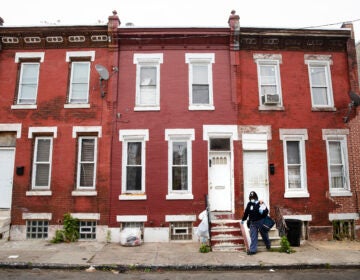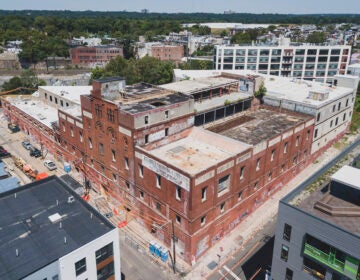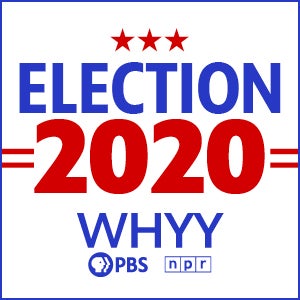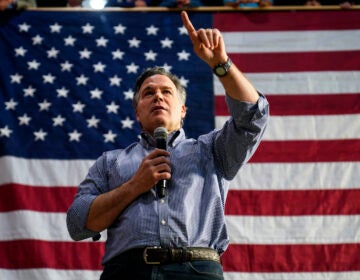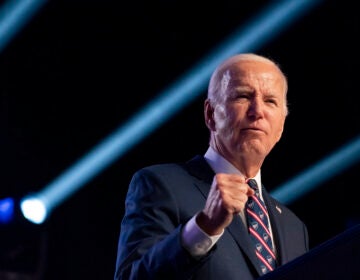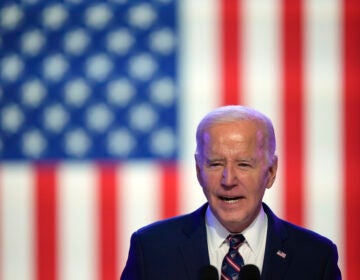Saving suburbia? Why housing is a hot topic in the 2020 election
Trump talks about keeping low-income housing out while Biden vows to help more families afford housing. Here’s what their promises mean for the region.
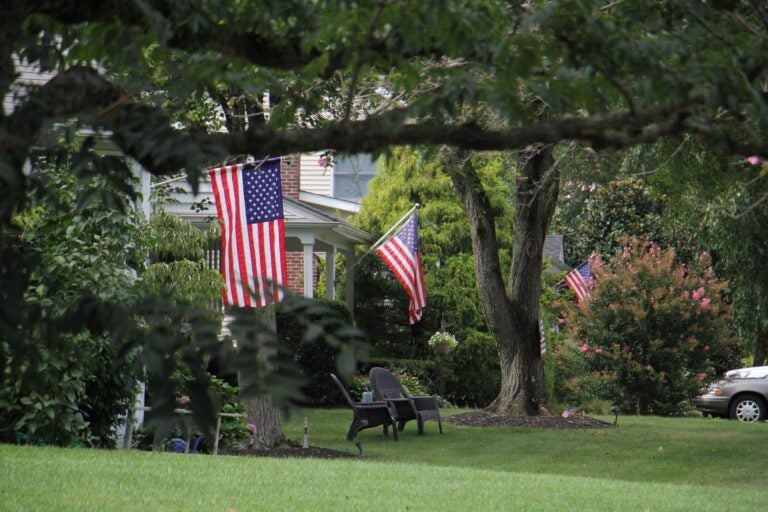
Flags fly from suburban homes in Moorestown, N.J.. (Emma Lee/WHYY)
Ask us: What do you want to know about voting and the 2020 election?
Donald Trump stood in an airplane hangar in Johnstown, Pennsylvania, and asked a favor of suburban women, with 21 days to go until the election. The president wanted to know, “Will you please like me?”
His pitch to women is one he’s been making regularly over the last several months of the presidential campaign — that he’ll keep federally subsidized housing away from them and their families.
“I saved your damn neighborhood, OK?” he said. “I don’t have that much time to be that nice.”
When Trump talks about saving neighborhoods, he’s talking mainly about dismantling a Barack Obama administration rule intended to hold municipalities accountable for fulfilling a civil-rights-era federal mandate to end housing segregation.
But his administration’s record of undoing fair housing protections extends far beyond that one program. Housing experts say this election could reshape the lives of millions of Americans who are affected in some way by federal housing policy — whether they live or want to live in federally subsidized housing, are finding themselves priced out of desirable neighborhoods and school districts, or are trying to stay rooted in gentrifying areas.
Rakia Brooks is one of those people.
She is 29, and lives in Philadelphia with her three children. Until about a year ago, they’d been moving “from pillow to pillow, kind of sort of here and there” fairly regularly, as she tried to figure out a more stable living situation.
She found her current Northeast Philly one-bedroom apartment in what she characterizes as a lucky break. The rent is $785 per month, plus utilities. Her $10-an-hour job as a home health aide covers it, but it’s tight, and the space is small for four people.
Brooks’s longtime goal has been to win a Section 8 spot. It might finally stop her cycle of endless moves, plus none of her kids would have to sleep on a pull-out couch anymore. She got on Philadelphia’s waiting list soon after her first son was born and checked in religiously to maintain her place.
Her son is almost 10 now. She never got a spot.
She’s not on the waiting list anymore, either. After one of her moves, Brooks thinks she missed a message from the Philadelphia Housing Authority.
“They just straight took me off that waiting list, no second chances,” she said. “I cried my freaking heart out, sorry for my language. It was really stressful for me.”
Brooks’ story is a common one. Philadelphia’s Section 8 waiting list is around 85,000 people long. And affordable housing shortages, and dilemmas like the one Brooks has been dealing with for a decade, aren’t limited to big cities.
Take suburban Montgomery County, for instance.
The unequal ‘suburban lifestyle dream’
Montgomery County is the kind of affluent and mostly white, but diversifying, suburban area Trump has targeted with tweets about protecting the “Suburban Lifestyle Dream” and promises to keep “low-income housing” out. It grapples with the same patterns of segregation that have resulted in a nationwide racial wealth gap, differing life expectancies predicted by ZIP code and other harbingers of inequality.
For instance, a child growing up in one section of Norristown could expect to live on a household income of around $24,000 in 2015 dollars while a peer just a few miles away in King of Prussia could anticipate a $65,000 median income, according to social mobility data released by the U.S. Census Bureau and Harvard researchers. Nearly 90% of the Norristown tract identified as Black or brown in 2010 while less than a third of the KOP area identified as not white, according to the Opportunity Atlas research. A search for Section 8 housing on the popular GoSection8 website turns up 21 listings in Norristown and zero in KOP, where rents average hundreds of dollars higher than in the neighbor to the east.
Joel Johnson heads the county’s housing authority. He said there are 2,300 vouchers for its Section 8 program, and estimates about 150 of them become available every year due to turnover. It’s not nearly enough to meet demand.
“We last accepted applications to that program in June of last year, and during the one-week online application opportunity, we received about 10,500 applications,” Johnson said, adding that the applicants represented entire households, not just individuals.
Montgomery County does have affordable housing options beyond Section 8. Johnson estimates there are about 3,500 privately-owned affordable homes, operated by nonprofits and other organizations. There are also 525 rental units that the county operates. The wait list for those, he noted, is open — but it has about 20,000 households on it.
“Between the Housing Authority and the other private affordable housing providers across the county, we’re not even anywhere close to meeting a quarter of the need for the households that qualify,” he said.
Even before the Obama administration began incentivizing municipalities to study and correct these patterns of segregation, Johnson said he and the rest of the Montgomery County Housing Authority tried to be “proactive.”
They regularly release reports on their work — including shortcomings. Last year, the authority reported spending 71% of federal community development grant dollars in areas already classified as “low and moderate income,” instead of in places where that investment could help people to move into areas with more economic opportunity.
“However, the County is also committed to investing [grant] resources in other [higher-income] areas of Montgomery County while continuing to benefit low and moderate income persons,” the report added.
Johnson said the authority has also tried other ways to get lower-income people out of the county’s poorest areas — like consistently finding apartments to subsidize that charge rents that are a little higher than HUD’s rent cap, to give people more options in wealthier areas.
Often, he says, the authority has been greeted “with open arms” when it wants to put affordable housing into new areas. But he added, challenges do pop up when trying to create income — and often by extension, racial — diversity.
“I think there’s been sort of a NIMBY response to affordable housing proposals here and there regardless of who’s in office,” he said. “That’s nothing new.”
Another big problem, Johnson said, is resources. He points to the backlog of capital needs in public housing around the country — the physical repairs and updates that need to be made to properties. In 2010, that number was estimated to be around $25 billion, and was expected to grow quickly.
Johnson said it’s probably north of $35 billion now. And like NIMBYism, he said, the problem didn’t start with Trump.
“The federal dollars are woefully insufficient, and that’s not just a reflection on this current administration,” he said. “That dates back a number of administrations.”
Ending ‘bigotry … allowable by law’
Though the Trump administration has repeatedly proposed budgets that would have significantly cut Department of Housing and Urban Development funding, those plans were uniformly rejected by Congress, and overall funding levels have not changed significantly from those under the Obama administration.
But Rasheedah Phillips, managing attorney for housing policy at Community Legal Services of Philadelphia, argues funding alone doesn’t paint a full picture of the differences between housing policy under Obama, and the current Trump model.
“I think what he’s doing is really just what he’s promised to do all along, which is to, in his mind, make America great again,” she said. “Which is a brand of America that teeters on the edge of explicit and de facto racism, and other forms of bigotry in a way that is allowable by law.”
Phillps is talking about a slew of big housing policy changes the Trump administration has proposed over the last several years. Like the funding cuts, many of these, too, have been stymied — but that hasn’t changed the administration’s overall policy direction.
HUD Secretary Ben Carson has tried to roll back a longstanding “disparate impact” rule, which provides that entities can be guilty of discrimination if they create unequal conditions for different people, even unintentionally. He also, among other things, proposed scaling back a rule that prevented transgender people from being turned away at homeless shelters, and pitched another change that would have banned families with undocumented members from receiving subsidized housing.
But one of the highest-profile changes, and the one that has figured most prominently in Trump’s campaign rhetoric, is his administration’s recent rollback of the signature Obama policy that required municipalities to study their own patterns of segregation and submit plans to fix them. If municipalities didn’t do their part, they risked being denied federal funding — a motivator for efforts to undo patterns of segregation in Montgomery County.
But Obama’s Affirmatively Furthering Fair Housing plan never took effect broadly, and the Trump administration first halted its implementation in 2018. The president didn’t formally announce that he was getting rid of it entirely until July, which was around the same time he began tweeting more frequently about the ways in which he believed affordable housing would ruin the ‘burbs.
I am happy to inform all of the people living their Suburban Lifestyle Dream that you will no longer be bothered or financially hurt by having low income housing built in your neighborhood…
— Donald J. Trump (@realDonaldTrump) July 29, 2020
It’s not surprising that Obama’s former second-in-command Joe Biden has grounded his housing proposals firmly in the same approach that Trump was committed to striking down.
Biden’s most eye-catching proposal is to provide Section 8 vouchers to every family that qualifies — a huge expansion. Right now, only about one in four renters considered “at risk” gets federal assistance. He also wants to make permanent a tax credit that people could put toward a first home purchase, and create a renters’ tax credit for low-income families who don’t qualify for Section 8.
He also wants to reinstate that Affirmatively Furthering Fair Housing rule that would have, under Obama, withheld certain block grants from municipalities if they didn’t study and address any discriminatory zoning or inequitable housing policies in their communities.
The campaign is also pitching a new, national standard for appraising houses. It’s meant to stop appraisers from, consciously or unconsciously, assigning lower value to homes owned by Black people — a well-documented pattern. A 2018 Brookings study found that homes in majority-Black neighborhoods are cumulatively valued 23% lower than homes in comparable neighborhoods where there are few or no Black residents.
Phillips doesn’t uniformly praise Democrats for their housing policy work. In blue-as-it-comes Philadelphia, for instance, she noted that many people fight zoning changes that could usher in denser, cheaper dwellings.
Some people, she said, “do not want to see affordable housing coming into their neighborhoods, in this great, diverse city.”
But she added, Trump goes beyond those common biases that can stand in the way of fairer housing.
“Literally everything he’s done since he’s gotten into office has been toward goals of eroding civil rights, eroding all of the strides that the country has made toward recognizing protections and rights for people who have been systemically and historically oppressed,” she said.
Suburbs are changing
Steve Fischer, who heads the Chester Housing Authority in suburban Delaware County, has spent decades watching the way policy shifts under different presidents.
Generally, he said, presidential administrations of recent history pointed their approach to housing in a certain direction: toward fairness, and toward mitigating the racist policies that did so much to shape where and how people live in the U.S.
Like Johnson, he said Chester has tried to be proactive and pursue AFFH desegregation goals, regardless of federal incentives.
There have always been challenges, even before Trump, inherent in trying to get people to support affordable housing, Fischer said. But he thinks there’s also been a steady trend in what he believes is the right direction.
“I think that suburban areas have grown to understand better that you need people at all different stages of the economic ladder to participate in making a community work,” Fischer said.
Under the president, he added, he hasn’t seen huge disruptions to his work. But what he has seen is a shift in direction that he worries could reverberate for years.
“It sounds like — I’m trying to be polite — a major turning back of the clock is being promoted,” he said.
As far as he can tell, Trump is retreading the same kind of rhetoric that, in the mid-20th century, was used to keep Black people out of mostly white developments.
But suburbs today don’t look like the suburbs of 1950. They’re much more racially diverse — a fact that Trump himself has noted. Chester, for instance, is a post-industrial community that had its heyday around World War II, and has been in economic decline since. It’s a predominantly Black area, and its residents these days are overwhelmingly poor. More than 60% of them are renters.
But the arguments Fischer now hears from Trump against affordable housing are couched in the same language as the arguments that once systematically kept Black people out of certain neighborhoods — concerns about property value, or a shattering of suburban peace.
“People like me who have worked in this for decades now, I think, to a person would tell you that that’s a fallacy,” Fischer said.
For people like Rakia Brooks, who are actively trying to survive and find housing assistance, the entire ideological debate over correct housing policy boils down to one question: Will it make a better house available for herself and her kids?
After almost 10 years on Philly’s Section 8 waiting list, and another year off of it, Brooks thinks she may have finally caught a break.
Last year, she learned about the Women’s Community Revitalization Project, which provides limited, subsidized housing to women in situations like hers. It’s funded through a combination of state and federal dollars, and contributions from private corporations that can receive federal tax credits for investing in affordable housing. Its waitlists tend to be significantly shorter than ones for Section 8 vouchers.
Brooks applied, and was shocked when the process moved along quickly. After a decade of moving “pillow to pillow,” she might soon have a permanent home that’s large enough for her family.
That home, if she wins a place, would be in a newly built affordable development in East Germantown. WRCP head Nora Lictash notes, it’s in an area that’s already pretty economically diverse, and not gentrifying particularly quickly — unlike, for instance, a larger project the WCRP is developing in the rapidly gentrifying Point Breeze section of South Philadelphia.
But Lictash adds, prices in Germantown are still going up, likely because of demand for student housing. She thinks it’s vital to make sure affordable options don’t go away.
“The idea is, planning to keep the good affordability that we have, for the residents who have put, sometimes for generations, effort into keeping these neighborhoods strong,” she said. “It’s so important.”
In Lictash’s experience, some people push back against affordable housing no matter where organizations like the WCRP try to put it. It happened in South Philadelphia, where neighborhoods are rapidly growing whiter and more expensive. And it happened in Germantown, where those trends aren’t nearly as strong.
“It’s hard in Point Breeze, it’s hard in West Philly,” Lictash said. “It’s hard.”
For people like Brooks, though, it’s a lifeline.
“[A better place to live] would be a really big blessing for me and my children,” she said. “We’re just waiting on that.”
 WHYY is one of over 20 news organizations producing Broke in Philly, a collaborative reporting project on solutions to poverty and the city’s push towards economic justice. Follow us at @BrokeInPhilly.
WHYY is one of over 20 news organizations producing Broke in Philly, a collaborative reporting project on solutions to poverty and the city’s push towards economic justice. Follow us at @BrokeInPhilly.

Subscribe to PlanPhilly
WHYY is your source for fact-based, in-depth journalism and information. As a nonprofit organization, we rely on financial support from readers like you. Please give today.




